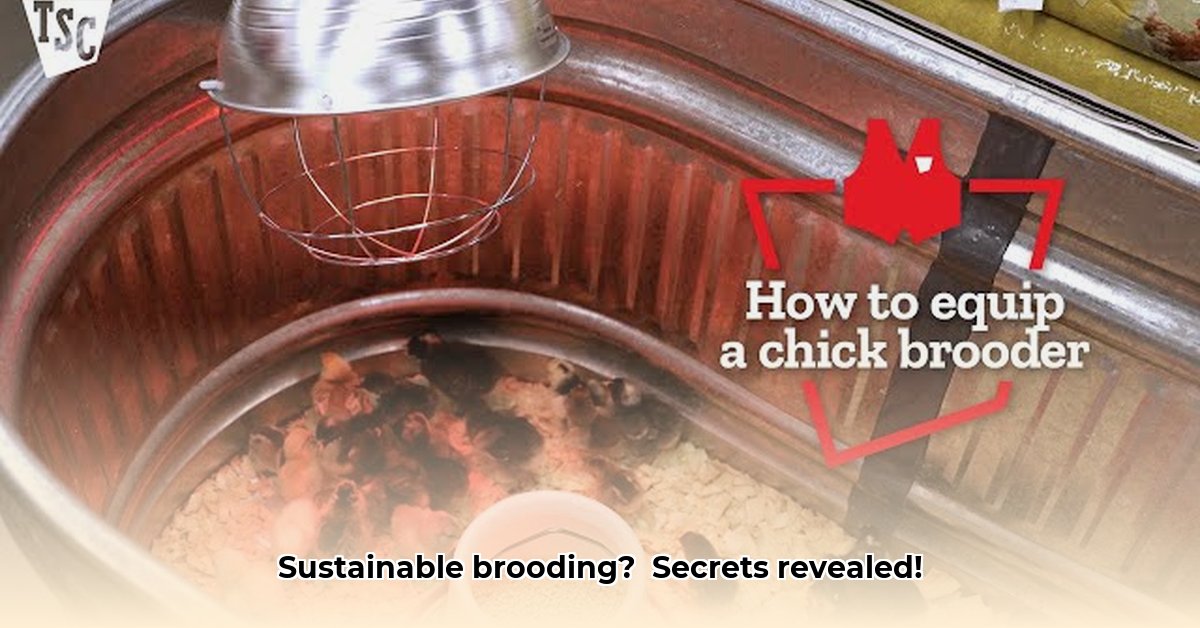
Raising healthy chicks sustainably is both environmentally responsible and economically beneficial. This guide focuses on using a Tractor Supply brooder plate as a core component of a sustainable brooding system for poultry farmers of all experience levels. For more information on Tractor Supply brooder plates, see this helpful resource.
Understanding Your Brooder Plate
A Tractor Supply brooder plate provides consistent warmth for your chicks, mimicking a mother hen's comforting embrace. This even heat distribution is vital for chick survival and growth, minimizing losses due to temperature fluctuations. This translates to healthier chicks and, ultimately, improved profitability.
Setting Up Your Brooder Plate: A Step-by-Step Guide
Cleanliness is paramount to prevent disease. Follow these steps for optimal results:
Step 1: Strategic Placement. Position the brooder plate centrally within the brooder to ensure uniform heat distribution.
Step 2: Precise Temperature Control. Use a reliable thermometer and adjust the brooder plate's settings according to your chicks' age and ambient temperature. Maintaining the correct temperature is critical; both overheating and chilling are dangerous. Research suggests a gradual temperature decrease as chicks mature is ideal.
Step 3: Choosing the Right Bedding. Select a clean, absorbent bedding material like straw, wood shavings, or recycled paper products. This keeps chicks dry and comfortable, contributing to their overall health.
Step 4: Easy Access to Food and Water. Provide shallow feeders and drinkers to prevent spills and drowning. Cleanliness and fresh supplies are key.
Brooder Plate Advantages: Why it's a Smart Choice
| Advantage | Detailed Explanation |
|---|---|
| Consistent Heat | Provides stable warmth, minimizing temperature stress. |
| Energy Efficiency | Often uses less electricity than other brooding methods, lowering costs. |
| Easy Cleaning | Smooth surface minimizes disease spread. |
| Improved Chick Survival | Stable environment reduces temperature-related losses. |
| Long-Term Cost Savings | Initial investment is offset by energy savings. |
Potential Brooder Plate Downsides
- Initial Cost: Brooder plates may be more expensive upfront than some alternative methods.
- Electricity Dependence: Power outages necessitate a backup power source (e.g., generator).
- Capacity Limitations: Plate size restricts the number of chicks per brooder; multiple plates may be needed for larger flocks.
Expanding Your Sustainable Brooding Strategy
Sustainable brooding extends beyond the brooder plate itself. Consider these additional practices:
- Local Sourcing: Purchase feed and bedding locally to reduce transportation emissions.
- Waste Management: Compost chick manure to create fertilizer and reduce landfill waste.
- Energy Conservation: Monitor energy usage and explore ways to conserve electricity, such as using alternative heating sources when climate conditions allow.
Building a Cost-Effective Sustainable Brooder
Building your own brooder gives you greater control over materials and design, potentially saving money while promoting sustainability.
Understanding Your Brooding Needs
Before you begin, assess your specific needs: the number of chicks, your budget, and your local climate. These factors will all impact the optimal brooder design and scale. Remember, adequate ventilation is crucial for chick health regardless of what equipment you use.
Heat Lamps vs. Brooder Plates: A Balanced Perspective
Heat lamps offer convenience but pose fire risks and are energy-intensive. Brooder plates are potentially safer and more energy-efficient but demand careful monitoring for even heat distribution.
Building a Brooder Plate System: A Practical Guide
- Plate Selection: Choose a plate appropriate for the number of chicks based on wattage and size.
- Housing Construction: Build a sturdy, well-ventilated enclosure using durable, preferably recycled, materials.
- Plate Installation: Securely mount the plate, keeping it away from flammable materials.
- Bedding Addition: Use safe, absorbent bedding like pine shavings or straw.
- Temperature Monitoring: Continuously monitor and adjust the temperature using a thermometer.
- Feeders and Waterers: Provide clean water and feed in appropriate, easily accessible receptacles.
Brooder Plate System: Weighing the Pros and Cons
| Pros | Cons |
|---|---|
| Energy efficiency | Higher initial investment |
| Reduced fire risk | Requires careful temperature monitoring |
| Consistent temperature control | Less adaptable to varied environmental conditions than heat lamps |
Optimizing for Sustainability: Beyond the Brooder
Sustainable brooding involves holistic practices. Prioritize recycled materials, efficient waste management, and strict hygiene to minimize environmental impact and maximize chick health. A comprehensive sustainable approach isn't just about the equipment – it's about all the components together.
In conclusion, a Tractor Supply brooder plate can be a cornerstone of a successful, sustainable poultry operation. By combining this technology with thoughtful management practices, you can raise healthy chicks while minimizing your environmental footprint and improving your bottom line. Remember to stay updated on the latest research and best practices to further refine your sustainable poultry farming methods.